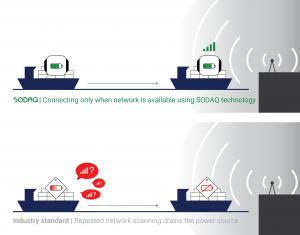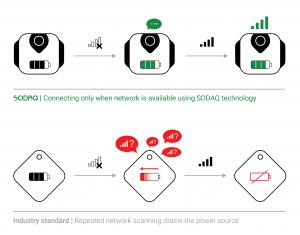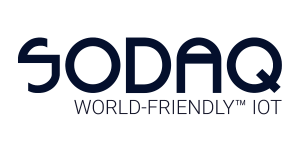Patent pending technology allows for global shipment tracking without draining power sources

SODAQ's solution ensures tracking devices continue to function after periods without available network connection.
Dutch low-power IoT expert SODAQ files patent for invention that harvests radio frequency (RF) energy for network sensing
Tracking devices play an important role in the reduction of risk, such as damage, theft or loss. In order to send data, these trackers rely on connections with cellular networks all over the world. But not many things drain the power source of a device faster than trying to connect to a network or send a message when there is no network available. While this is a common event for global shipment trackers, it results in an ongoing effort to find connectivity. This continuous search can use 50 to 100 times more power than sending a message when a network is available. This causes batteries or capacitors to die sooner than they should, leading to needlessly high usage of power sources and lost tracking capabilities. This challenge is the driving force to SODAQ’s new patent pending solution.
RF energy harvesting for network sensing
This new invention is a sensor based on an antenna which harvests power to measure if there is an available network. This happens through radio frequency (RF) energy harvesting, as the antenna converts received RF signals into power.
The sensor is placed within a tracking device that can be positioned in a location with or without connection. Before attempting to connect to a network, the device measures the harvested power on a small capacitor or buffer. Measuring the voltage on the buffer shows if it is above a certain threshold. If it is, the device can assume there is an available network, and the connection can be made. If the buffer is zero or low, it means that there is no network, and the sending of this message can be skipped. Itay Dagan, CTO at SODAQ: “Using SODAQ's technology, assets such as containers can be tracked anywhere in the world without having to worry about running out of battery power when there is no communication network coverage.”
Only little energy required
Most energy harvesting research is focused on harvesting energy to power up devices or store large amounts of energy. This requires high-input power levels and large directive antennas. However, in this case, far less harvested energy is required because this energy is only used to sense whether there is an available network to send data. When a device decides there is no network available, it does not need to spend any more energy trying to connect to a network. The on-time of devices is longer when using this solution. When a network does become available, the device still has the power available to connect and send out information until the end of its journey.
Efficiency for global shipments
For this solution there are multiple use cases related to global shipments, such as:
- Global sea freight shipping: long-term allocating or passing through locations without connectivity
- Truck and container trackings, both on land and sea: shipments allocated in sheltered places without connectivity
An example case study: A SODAQ TRACK with a shipment traveling from the Port of Rotterdam to Singapore. During its 25 days traveling by sea, it only has connectivity in the harbors, so it will only connect when it is relevant. Without the new solution on the TRACK, there would be a constant search for a network, draining the battery much faster than it should. But now, when the shipment arrives in Singapore, the TRACK still has enough power to connect and stay connected until arrival at its destination. SODAQ’s testing has proven this solution to be 130 times more efficient compared to the existing network sensing.
A future without replacing batteries
Dagan gives a sneak peek of what the future of supply chain management will be like: “IoT trackers will be able to operate in any environment without the need to replace batteries, utilizing all necessary power from their surrounding energy sources: sunlight and radio waves.
This will make IoT devices more sustainable as significantly fewer raw materials for batteries will be needed to support continuous tracking functions.”
SODAQ’s energy harvesting solution is patent pending, yet already available in combination with their range of tracking devices.
For more information, visit www.sodaq.com or get in touch through sales@sodaq.com.
Stephanie Zumbrink
SODAQ
+31 35 300 0301
sales@sodaq.com
Visit us on social media:
Twitter
LinkedIn
Legal Disclaimer:
EIN Presswire provides this news content "as is" without warranty of any kind. We do not accept any responsibility or liability for the accuracy, content, images, videos, licenses, completeness, legality, or reliability of the information contained in this article. If you have any complaints or copyright issues related to this article, kindly contact the author above.


